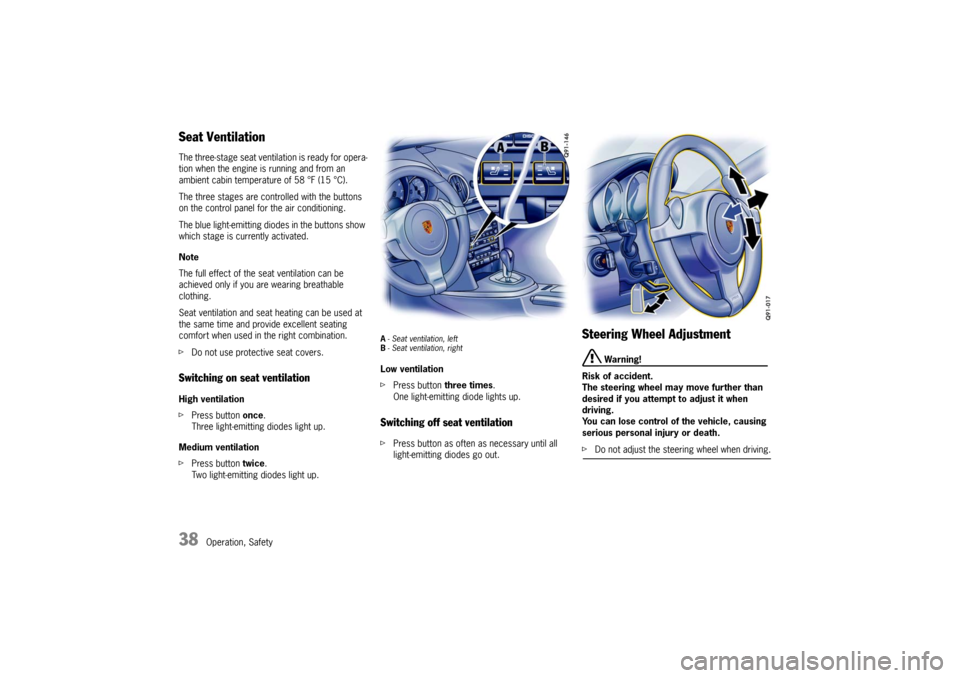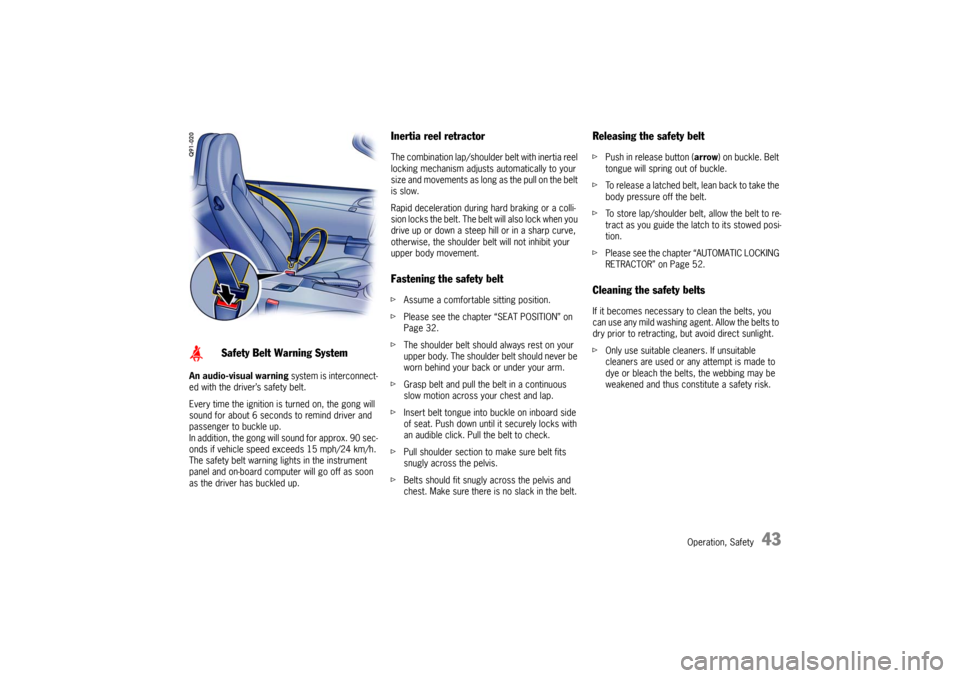2010 PORSCHE BOXSTER S warning lights
[x] Cancel search: warning lightsPage 8 of 294

6
Table of ContentsTable of ContentsPorsche Ceramic Composite Brake (PCCB) ...... 4
Setting and operating vehicle components
when driving .................................................. 4
Portable Fuel Contain ers ................................ 4
Ground Clearance ...... .................................... 4
Engine Exhaust .......... .................................... 5Before driving off................................. 8Before driving off... ........................................ 8
Break in hints for the first
2,000 miles/3,000 kilo meters ...................... 10Operation, Safety ............................... 13Keys ........................ .................................. 15
Security Wheel Bolts .................................... 15
Doors ................................................ ......... 18
Central Locking in Cars without Alarm System 19
Central Locking in Cars with Alarm System ... 21
Alarm System,
Passenger Compartment Monitoring ............. 25
Power Windows ............. .............................. 27
Mirrors ...................... .................................. 29
Rear Window Defogger, Door Mirror Heating .. 31
Seat Adjustment and Head Restraints ............ 32
Seat Memory ............. .................................. 35
Heated Seats ............ .................................. 37
Seat Ventilation ...... ...................................... 38
Steering Wheel Adjust ment ........................... 38
Steering Wheel Heatin g ................................ 39
Multi-Functional Steering Wheel ..................... 40 Sun Visors ...............
....................................41
Safety Belts ............. ....................................42
Airbag Systems ....... ....................................44
Child Restraint System s ................................50
LATCH System
Child seat bracket on the passenger’s seat ....54
Sports Exhaust System ................................55
Parking Brake .......... ....................................55
Brakes ................... ....................................56
ABS Brake System (Antilock Brake System) ...59
Clutch Pedal ................ ................................60
Sport Mode ................. ................................61
Porsche Stability Manage ment (PSM) .............63
Porsche Active Suspension Management
(PASM) ........................ ................................66
Retractable Spoiler .. ................................... 67
Fixed rear spoiler . ........................................68
Interior lights ................................ ...............69
Parking Aids ........... ....................................70
Ignition/Starter Switch with
anti-theft Steering Lo ck .................................72
Starting Procedures .....................................75
Stopping Engine .. ........................................76
Emergency Flasher Swit ch ............................77
Light Switch on Vehicles
with Bi-Xenon Headlig hts ...............................78
Light Switch on Vehicles
with Halogen Headlights ...............................80
Turn Signal / Headlight Dimmer /Parking light /
Flasher Lever ........... ....................................81
Windshield Wiper/ Washer Lever ...................82
Automatic Speed Contro l ..............................
84Cupholder ...................
................................ 86
Ashtray ....................... ................................ 87
Cigarette Lighter .... ..................................... 88
Storage in the Passenger Compartment ........ 89
Luggage Storage on Engine Compartment Lid 91
Luggage Compartment Li ds ......................... 92
Luggage Compartment ................................ 94
Rear luggage compartm ent .......................... 94
Trunk Entrapment .. ..................................... 95
Porsche Communication Management (PCM) . 97
Car Telephone and Aftermarket Alarms ........ 99
iPod, USB and AUX . ................................... 100
Fire Extinguisher .... ................................... 101
HomeLink ................... .............................. 102
Automatic Air Conditioning System,
Heated Rear Window/
Door Mirror Heating. ........................ 105Air Conditioning ...... ................................... 106
Automatic Air Conditioning System ............. 109
Central and Side Vents ............................. 112
Fresh-air Intake . ....................................... 112
Heated Rear Window/Door Mirror Heating ... 113Instruments, On-Board Computer,
Warnings ........................................ 115Instrument Panel USA Models ..................... 116
Instrument Panel Canada Models ................ 118
Automatic Speed Control Indicator light ...... 120
Instrument Illumination ............................... 120
Page 9 of 294

Table of Contents
7
Trip Odometer ........................................... 121
Speedometer ................ ............................ 122
Changing over between Miles / Kilometers .. 122
Tachometer ............... ................................ 123
Turn Signal Indicator Light .......................... 123
High Beam Indicator Li ght ........................... 123
Gear Shift Indicator
(in vehicles with manual transmission) .......... 123
Cooling System ......... ................................ 124
Porsche Doppelkupplung (PDK) ................... 125
Fuel .......................... ................................ 126
Clock ............................ ............................ 127
Outside Temperature ................................. 127
Check Engine (Emission Control) ................. 129
On-Board Computer (B C) ............................ 130
Warnings on the instrument panel and the on-
board computer ............. ............................ 162Shifting Gears.................................. 171Manual Transmission, Cl utch ....................... 172
Drive-Off Assistant ..... ................................ 173
Porsche Doppelkupplung (PDK) ................... 174Mobile Roofs ................................... 181Convertible Top ......... ................................ 182
Windstop ................... ................................ 189
Hardtop ........................ ............................ 190Maintenance, Car Care .................... 195Exercise Extreme Caution when Working
on your Vehicle .......................................... 196
Coolant Level ............ ................................ 197
Engine Oil ................. ................................ 199 Engine Oil Level ..
......................................199
Engine Oil Recommendat ion ........................200
Brake Fluid Level ...... ..................................202
Fuel Economy .......... ..................................204
Operating your Porsche in other Countries ...204
Fuel Recommendation s ..............................206
Portable Fuel Containers ............................207
Fuel Evaporation Control ............................207
Emission Control Syst em ............................208
How Emission Control Works ......................209
Washer Fluid ............ ..................................210
Power Steering ........ ..................................211
Air Filter .................. ..................................211
Combination Filter .... ..................................211
Fluids/Oils for Manual Transmission
and Porsche Doppelkuppl ung (PDK) .............211
Wiper Blades .......... ..................................212
Car Care Instructions ................................213
Practical Tips, Emergency Service .... 221Exercise Extreme Caution when Working
on your Vehicle ............................ .............222
Tires/Wheels ............... ............................. 223
Loading Information ...................... .............234
Wheel Bolts ................................. .............236
Changing a wheel .......................... .............237
Flat Tire........................ ............................. 239
Lifting the Vehicle with a Lifting Platform
or Garage Lift ...... ......................................242
Spacers ...................... ..............................243
Electrical System ......................................245
Battery ................... ..................................249
Replacing the remote-control battery ..........254
Emergency Starting with Jumper Cables ......255 Bulb chart ..............
................................... 257
Lights, Replacing Bulb s ............................. 257
Headlights ............. ................................... 258
Number Plate Light . ................................... 266
Changing Light-Emitting Diodes and Long-Life
Bulbs ......................... .............................. 266
Adjusting Headlights .................................. 267
Towing ....................... .............................. 269
Vehicle Identification,
Technical Data ......... ....................... 273Vehicle Identification .................................. 274
Technical Data ....... ................................... 276
Tire Pressure for Cold Tires ....................... 277
Tires, Rims, Tracks .................................. 278
Driving Performance* ................. .............. 280
Capacities ............. ................................... 281
Weights ..................... .............................. 282
Dimensions ........... ................................... 282
Diagrams ................... .............................. 283
Page 11 of 294

Before driving off...
9
In the driver’s seat... fCheck operation of the horn.
f Position seat for easy reach of foot pedals and
controls.
To reduce the possibility of injury from the
airbag deployment, you should always sit back
as far from the steering wheel as is practical,
while still maintaining full vehicle control.
f Adjust the inside and outside rear view mirrors.
f Buckle your safety belts.
f Check operation of the foot and parking brake.
f Check all warning and indicator lights with
ignition on and engine not running.
f Start engine and check all warning displays for
warning symbols.
f Never leave an idling car unattended.
f Lock doors from inside, especially with chil-
dren in the car to prevent inadvertent opening
of doors from inside or outside.
Drive with doors locked.
On the road... fNever drive after you have consumed alcohol
or drugs.
f Always have your safety belt fastened.
f Always drive defensively.
Expect the unexpected.
f Use signals to indicate turns and lane changes.
f Turn on headlights at dusk or when the driving
conditions warrant it.
f Always keep a safe distance from the vehicle in
front of you, depending on traffic, road and
weather conditions.
f Reduce speed at night and during inclement
weather.
Driving in wet weather requires caution and re-
duced speeds, particularly on roads with
standing water, as the handling characteristics
of the vehicle may be impaired due to hydro-
planing of the tires.
f Always observe speed limits and obey road
signs and traffic laws.
f When tired, get well off the road, stop and take
a rest. Turn the engine off. Do not sit in the ve-
hicle with engine idling.
Please see the chapter “ENGINE EXHAUST” on
Page 5. f
When parked, always set the parking brake.
Move the PDK selector le ver to ”P“ or the gear-
shift lever to reverse or first gear.
On hills also turn the front wheels toward the
curb.
f When emergency repairs become necessary,
move the vehicle well off the road. Turn on the
emergency flasher and use other warning de-
vices to alert other motorists. Do not park or
operate the vehicle in areas where the hot ex-
haust system may come in contact with dry
grass, brush, fuel spill or other flammable ma-
terial.
f Make it a habit to have the engine oil checked
with every refueling.
Page 22 of 294

20
Operation, Safety
The central locking switch on the dashboard lets
you lock and unlock both doors electrically.
Note
If the doors are locked with the key or remote
control, they can not be opened by pressing the
central locking switch. Locking
f
Press the rocker-switch.
Indicator light in the rocker switch lights up if
ignition is on.
If the doors were locked with the central
locking switch, they can be opened by pulling
the inner door handle twice.
Unlocking
f Press the rocker-switch.
Indicator light goes off.
Automatic door locking Your authorized Porsche dealer can program
diverse types of automatic door locking in the
control unit of the central locking system.
Ty p e 1
Doors lock automatically when the ignition is
switched on.
Ty p e 2
Doors lock automatically when a speed of
3 - 6 mph (5 - 10 km/h) is exceeded. Ty p e 3
Doors lock automatically
when the ignition is
switched on. If doors are opened with the engine
running, they lock again automatically when a
speed of 3 - 6 mph (5 - 10 km/h) is exceeded.
Ty p e 4
The doors do not lock automatically.
Note
Automatically locked doors can be unlocked with
the central locking button or opened by pulling on
the inside door handle twice.
On vehicles with the Sport Chrono Package Plus,
the PCM can be used to activate automatic door
locking.
f Please see the chapter ”Individual Memory“ in
the separate PCM operating instructions.
Warning!
In an emergency situation where you need to
exit the car through an automatically locked
door, remember the following procedure to
open the door.
f Unlock the doors by pressing the central
locking button or
f pull the inside door handle twice to open the door.
Central locking switch
Page 33 of 294

Operation, Safety
31
Note
The incident light in the area of the sensors must
not be restricted, e.g. by stickers on the wind-
shield.
Switching off the automatic anti-glare
operation
fPress switch B.
Light-emitting diode C goes out.
Switching on the automatic anti-glare
operation
f Press switch B.
Light-emitting diode C lights up.
Warning!
Risk of injury. Electrolyte fluid can emerge
from a broken mirror glass.
This fluid irritates the skin and eyes.
f If the electrolyte fluid should come into contact
with the eyes or skin, immediately rinse it off
with clean water.
See a doctor if necessary.
Risk of damage to the paintwork, leather and
plastic parts. Electrolyte fluid can be
removed only while it is still wet.
f Clean the affected parts with water. The mirror heater is ready for operation when the
ignition is on.
Switching on f
Press button.
The light-emitting diode in the button lights up.
After approx. 15 minutes, the heater switches off
automatically.
The heater can be switched back on by pressing
the button again.Switching off f Press button.
The light-emitting diode in the button goes out.
Rear Window Defogger,
Door Mirror Heating
Page 40 of 294

38
Operation, Safety
Seat VentilationThe three-stage seat ventilation is ready for opera-
tion when the engine is running and from an
ambient cabin temperature of 58 °F (15 °C).
The three stages are controlled with the buttons
on the control panel for the air conditioning.
The blue light-emitting diodes in the buttons show
which stage is currently activated.
Note
The full effect of the seat ventilation can be
achieved only if you are wearing breathable
clothing.
Seat ventilation and seat heating can be used at
the same time and provide excellent seating
comfort when used in the right combination.
f Do not use protective seat covers.Switching on seat ventilationHigh ventilation
fPress button once.
Three light-emitting diodes light up.
Medium ventilation
f Press button twice.
Two light-emitting diodes light up.
A - Seat ventilation, left
B - Seat ventilation, rightLow ventilation
f Press button three times.
One light-emitting diode lights up.Switching off seat ventilationf Press button as often as necessary until all
light-emitting diodes go out.
Steering Wheel Adjustment
Warning!
Risk of accident.
The steering wheel may move further than
desired if you attempt to adjust it when
driving.
You can lose control of the vehicle, causing
serious personal injury or death.
f Do not adjust the steeri ng wheel when driving.
Page 44 of 294

42
Operation, Safety
Safety Belts
Warning!
Always make sure your and your passenger’s
safety belts are properly fastened while the
vehicle is in motion.
Failure to follow safety belt warnings may re-
sult in serious personal injury or death.
f For your and your passenger’s protection, use
safety belts at all times while the vehicle is in
motion.
f Use appropriate child restraint systems for all
small children.
Proper wearing of safety belts
f S a f e t y b e l t s m u s t b e p o s i t i o n e d o n t h e b o d y a s
to restrain the upper body and lap from sliding
forward. Improperly positioned safety belts
can cause serious personal injury or death in
case of an accident.
f The shoulder belt should always rest on your
upper body. The shoulder belt should never be
worn behind your back or under your arm.
f For maximum effectiveness, the lap belt
should be worn low across the hips.
f Pregnant women should position the belt as
low as possible across the pelvis. Make sure it
is not pressing against the abdomen. f
Belts should not be worn twisted.
f Do not wear belts over rigid or breakable ob-
jects in or on your clothing, such as eye glass-
es, pens, keys, etc. as these may cause injury.
f Several layers of heavy clothing may interfere
with proper positioning of belts.
f Belts must not rub against sharp objects or
damage may occur to the belt.
f Two occupants should never share the same
belt at the same time.
Care and maintenance
f Keep belt buckles free of any obstruction that
may prevent a secure locking.
f Belts that have been subjected to excessive
stretch forces in an accident must be inspect-
ed or replaced to ensure their continued effec-
tiveness in restraining you.
The same applies to belt tensioner systems
which have been triggered.
In addition, the anchor points of the belts
should be checked.
f If safety belts do not work properly, see your
authorized Porsche dealer immediately.
f I f t h e b e l t s s h o w d a m a g e t o w e b b i n g , b i n d i n g s ,
buckles or retractors, they should be replaced
to ensure safe operation.
f Do not modify or disasse mble the safety belts
in your vehicle. f
The belts must be kept clean or the retractors
may not work properly.
Please see the chapter “CAR CARE INSTRUC-
TIONS” on Page 213.
f Never bleach or dye safety belts.
f Do not allow safety belts to retract until they
are completely dry after cleaning or this may
cause damage to the belt.
Belt tensioner Depending on the force of an impact, fastened
safety belts are tightened in an accident.
The belt tensioners are triggered in:
– Front, side and rear impacts of sufficient
severity.
– In cases of vehicle rollover.
Note
The belt-tensioner system can be triggered only
once; the system must be replaced afterward.
If there is a fault in the belt-tensioner system, the
airbag warning light lights up.
Work may be performed on the belt-tensioner sys-
tem only by an authorized Porsche dealer.
Smoke is released when the belt tensioners are
triggered. This does not indicate a fire in the
vehicle.
Page 45 of 294

Operation, Safety
43
An audio-visual warning system is interconnect-
ed with the driver ’s safety belt.
Every time the ignition is turned on, the gong will
sound for about 6 seconds to remind driver and
passenger to buckle up.
In addition, the gong will sound for approx. 90 sec-
onds if vehicle speed exceeds 15 mph/24 km/h.
The safety belt warning lights in the instrument
panel and on-board computer will go off as soon
as the driver has buckled up.
Inertia reel retractor The combination lap/shoulder belt with inertia reel
locking mechanism adjusts automatically to your
size and movements as long as the pull on the belt
is slow.
Rapid deceleration during hard braking or a colli-
sion locks the belt. The belt will also lock when you
drive up or down a steep hill or in a sharp curve,
otherwise, the shoulder belt will not inhibit your
upper body movement.Fastening the safety beltf Assume a comfortable sitting position.
f Please see the chapter “SEAT POSITION” on
Page 32.
f The shoulder belt should always rest on your
upper body. The shoulder belt should never be
worn behind your back or under your arm.
f Grasp belt and pull the belt in a continuous
slow motion across your chest and lap.
f Insert belt tongue into buckle on inboard side
of seat. Push down until it securely locks with
an audible click. Pull the belt to check.
f Pull shoulder section to make sure belt fits
snugly across the pelvis.
f Belts should fit snugly across the pelvis and
chest. Make sure there is no slack in the belt.
Releasing the safety beltf Push in release button (arrow ) on buckle. Belt
tongue will spring out of buckle.
f To release a latched belt, lean back to take the
body pressure off the belt.
f To store lap/shoulder belt, allow the belt to re-
tract as you guide the latch to its stowed posi-
tion.
f Please see the chapter “AUTOMATIC LOCKING
RETRACTOR” on Page 52.Cleaning the safety beltsIf it becomes necessary to clean the belts, you
can use any mild washing agent. Allow the belts to
dry prior to retracting, but avoid direct sunlight.
f Only use suitable cleaners. If unsuitable
cleaners are used or any attempt is made to
dye or bleach the belt s, the webbing may be
weakened and thus constitute a safety risk.
Safety Belt Warning System